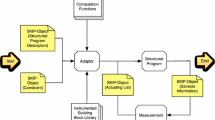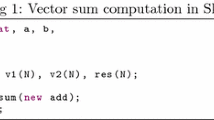Abstract
Skeletons simplify parallel programming by providing general patterns of parallel computations. When several skeletons are used inside the same program, skeleton composition usually leads to aggregation and redistribution of the intermediate data on a single process. Though the programmer can overcome the performance loss at a lower level of abstraction by altering the existing skeletons or not using them at all. A high-level concept like skeleton-based programming, however, calls for a more general solution.
Remote data provides runtime mechanisms that allow declaratively specified processes to access other processes’ data via remote handles. This enables the programmer to easily build complex skeletons by combining simpler ones. Skeletons can be composed without the drawback of collecting and then redistributing the data in between two skeleton instances. Another advantage is that skeletons which inherently depend on their inner communication patterns are easily implemented using remote data. We present the implementation of remote data in the parallel functional language Eden and show the definition of some example skeletons with a remote data interface.
Preview
Unable to display preview. Download preview PDF.
Similar content being viewed by others
References
Alt, M.: Using Algorithmic Skeletons for Efficient Grid Computing with Predictable Performance. PhD thesis, Universität Münster (July 2007)
Alt, M., Gorlatch, S.: Future-Based RMI: Optimizing compositions of remote method calls on the Grid. In: Kosch, H., Böszörményi, L., Hellwagner, H. (eds.) Euro-Par 2003. LNCS, vol. 2790, pp. 427–430. Springer, Heidelberg (2003)
Alt, M., Gorlatch, S.: Adapting Java RMI for grid computing. Future Generation Computer Systems 21(5), 699–707 (2004)
Berthold, J., Dieterle, M., Loogen, R.: Implementing Parallel Google Map-Reduce in Eden. In: Sips, H., Epema, D., Lin, H. (eds.) Euro-Par 2009. LNCS, vol. 5704, pp. 990–1002. Springer, Heidelberg (2009)
Cole, M.: Algorithmic Skeletons: Structured Management of Parallel Computation. MIT Press, Cambridge (1989)
Darlington, J., Guo, Y.-k., To, H.W., Yang, J.: Parallel skeletons for structured composition. In: PPOPP 1995: Proceedings of the fifth ACM SIGPLAN symposium on Principles and practice of parallel programming, pp. 19–28. ACM, New York (1995)
Kuchen, H., Cole, M.: The integration of task and data parallel skeletons. Parallel Processing Letters 12(2), 141–155 (2002)
Lobachev, O., Berthold, J., Dieterle, M., Loogen, R.: Parallel FFT using Eden Skeletons. In: Malyshkin, V. (ed.) PaCT 2009. LNCS, vol. 5698, pp. 73–83. Springer, Heidelberg (2009)
Loogen, R., Ortega-Mallén, Y., Peña-Marí, R.: Parallel Functional Programming in Eden. Journal of Functional Programming 15(3), 431–475 (2005)
Author information
Authors and Affiliations
Editor information
Editors and Affiliations
Rights and permissions
Copyright information
© 2010 Springer-Verlag Berlin Heidelberg
About this paper
Cite this paper
Dieterle, M., Horstmeyer, T., Loogen, R. (2010). Skeleton Composition Using Remote Data. In: Carro, M., Peña, R. (eds) Practical Aspects of Declarative Languages. PADL 2010. Lecture Notes in Computer Science, vol 5937. Springer, Berlin, Heidelberg. https://doi.org/10.1007/978-3-642-11503-5_8
Download citation
DOI: https://doi.org/10.1007/978-3-642-11503-5_8
Publisher Name: Springer, Berlin, Heidelberg
Print ISBN: 978-3-642-11502-8
Online ISBN: 978-3-642-11503-5
eBook Packages: Computer ScienceComputer Science (R0)




